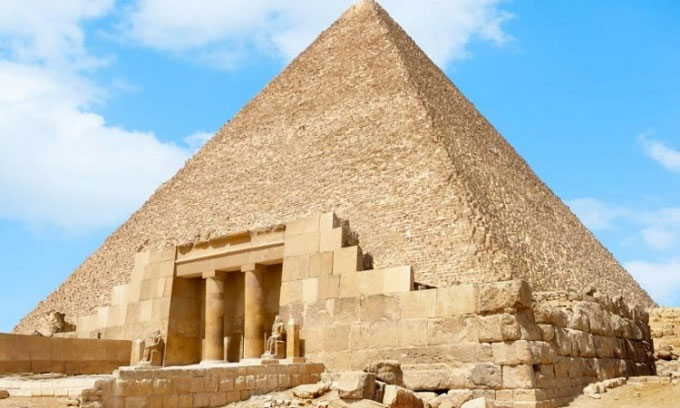Researchers use cosmic rays to scan the Great Pyramid of Giza
For the first time, researchers will create tomography images of an ancient pyramid weighing nearly 6 million tons to uncover hidden chambers inside.
A team of scientists will scan the Great Pyramid of Khufu at Giza with muons in cosmic rays. They wanted to take a closer look at the pyramid than before and map its internal structure. This effort is called the Exploration of the Great Pyramid (EGP) mission.

The Great Pyramid of Giza is one of the 7 ancient wonders.
The mission will use muon tomography to take pictures of the inside of the building. EGP's muon telescope system will be 100 times more powerful than the ScanPyramids project in 2016 - 2017. "We'll be taking pictures of muons from nearly any angle and creating a true tomographic image of a structure for the first time. such a large image instead of a two-dimensional image," the EGP researchers said.
The EGP will use very large telescope sensors that move around different locations outside the Great Pyramid. The detector will be assembled in an air-conditioned container for easy transportation. Each device is 12 meters long, 2.4 meters wide and 2.9 meters high. The simulation will use two muon telescopes, each consisting of 4 containers.
EGP is still building the telescope prototype and determining the data processing technique it will use. At the same time, they are creating simulations and doing other work to prepare for the mission. Using a telescope located outside the Great Pyramid on the Giza Plateau could produce much higher resolution images due to the large number of muons detected.
Muons are elementary particles similar to electrons but much larger. They are used in tomography because of their ability to penetrate deeper into structures than X-rays. Muons in cosmic rays are created when high-energy particles crash into Earth's atmosphere. Cosmic rays consisting of protons and atomic nuclei frequently travel from the Sun, the outer solar system and the Milky Way to Earth. When these particles collide with the Earth's atmosphere, the process produces showers of secondary particles, among them muons.
Muons are unstable and decay in just a few microseconds or a few millionths of a second. But they travel as fast as the speed of light, able to penetrate deep into objects before decaying. The source of muons from cosmic rays hitting the Earth is endless. Muon tomography has a variety of applications such as inspection of shipping containers. Recent achievements in this industry lead to new applications. For example, Italian scientists will use muon tomography to take pictures of the inside of the Vesuvius volcano to find out when the mountain will erupt again.
The Great Pyramid of Giza has existed since the 26th century BC. This is the tomb of pharaoh Khufu aka Cheops. Construction took about 27 years. The work was built with 2.3 million stone blocks, a combination of limestone and granite, weighing about 6 million tons. For more than 3,800 years, it was the tallest man-made structure in the world. What we see today is only the underlying core structure of the Great Pyramid. The smooth white limestone crust has been worn down over time. The pyramid and the ground below include many rooms and corridors. The chamber where the pharaoh Khufu is located is located in the center of the pyramid.
- The Great Pyramid of Giza can be built on top of a huge natural hill
- The hidden room in the Great Pyramid may contain the pharaoh's throne
- The dreadful moment when exploring the Great Pyramid 4,500 years
- Two cavities cannot be explained in the Great Pyramid of Egypt
- The Great Pyramid of Giza has a large error in construction
- Video: Airship robot explores the hidden room in the Great Pyramid
- For the first time, 3D images of the structure inside the pyramid were revealed
- Construction errors caused the Great Egyptian pyramid to deviate
- Pyramids of Giza and 4 unsolved human mysteries
- The incredible similarity between the Bosnian and Giza pyramids
- Pyramid explorer robot
- The exact date of the construction of the Giza pyramid?
 The truth about the mysterious red-haired giant at Lovelock Cave
The truth about the mysterious red-haired giant at Lovelock Cave Inunaki Tunnel: The haunted road leading into Japan's 'village of death'
Inunaki Tunnel: The haunted road leading into Japan's 'village of death' The mystery of the phenomenon of human reflection before dying
The mystery of the phenomenon of human reflection before dying 6 mysterious phenomena, although science has been developed for a long time, still cannot be answered
6 mysterious phenomena, although science has been developed for a long time, still cannot be answered